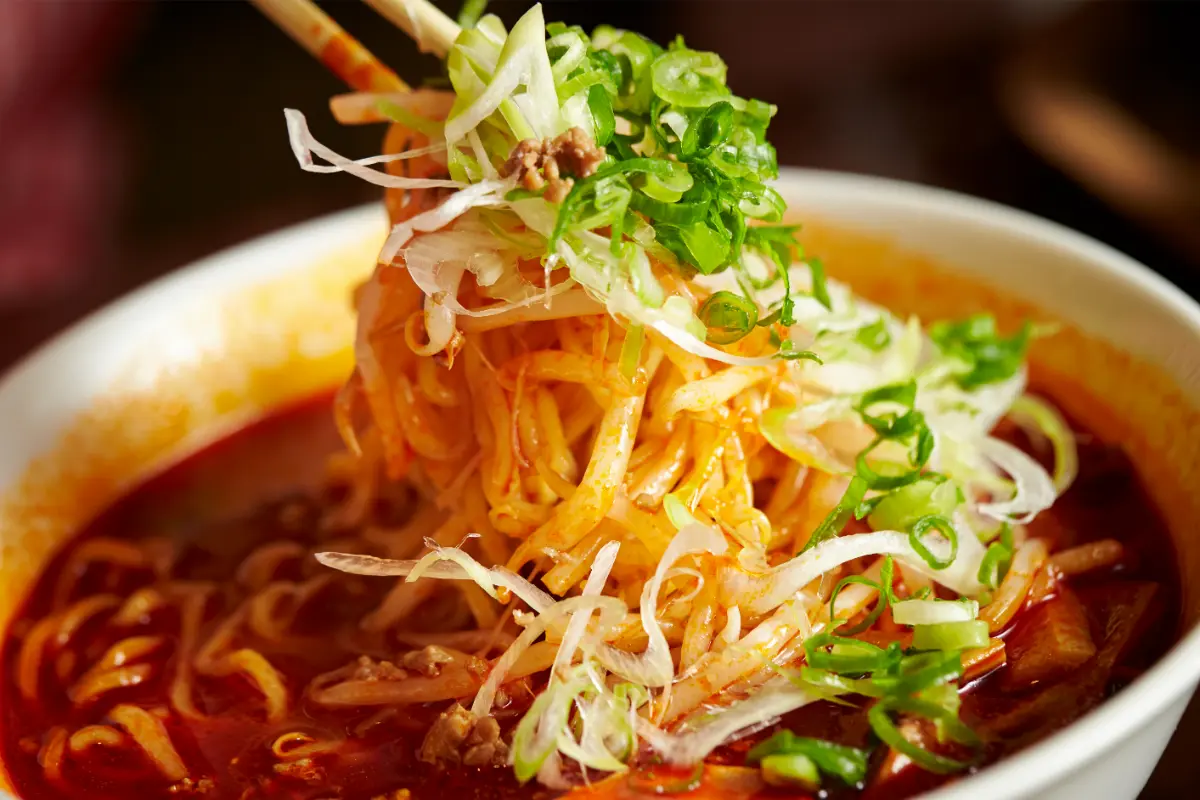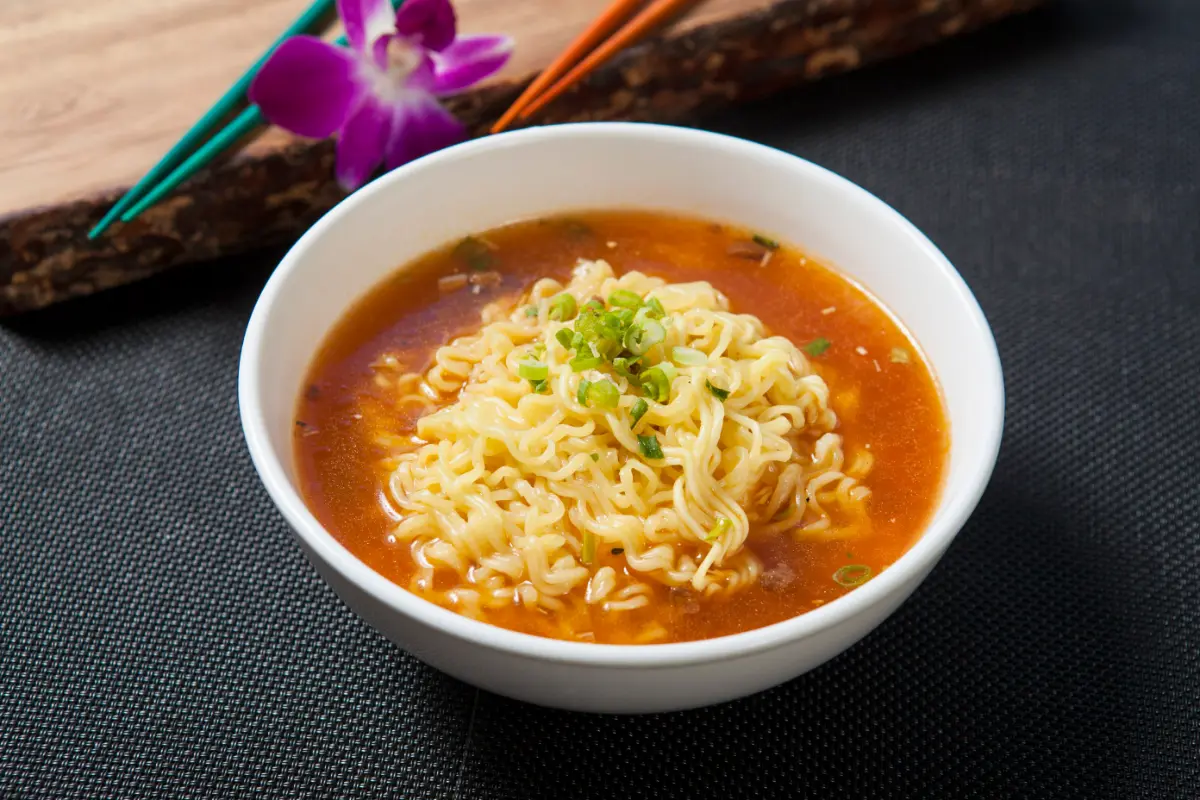Introduction
Ramen noodle soup is a dish that has captured the hearts of many around the world. This comforting, savory, and satisfying meal has become a staple in many cuisines, from traditional Japanese ramen to modern adaptations and variations. Whether you’re a foodie, a busy professional, or simply someone looking for a quick and easy meal, ramen noodle soup has something to offer. In this article, we will explore the history, cultural significance, and various preparation and enjoyment methods of ramen noodle soup.
The Evolution of Ramen Noodle Soup
Traditional Japanese ramen noodle soup
Ramen noodle soup has its roots in Japanese cuisine, where it’s known as “ramen” or “chuka soba.” China introduced this popular dish to Japan in the early 20th century. Over time, Japanese cooks adapted the recipe to suit local tastes, creating a distinct style that’s both familiar and unique. The classic Japanese ramen noodle soup is characterized by its rich, savory broth, made with pork or chicken stock, and served with springy noodles, sliced pork, a boiled egg, and green onions.
As ramen noodle soup spread globally, it evolved to incorporate local flavors and ingredients. For instance, many Asian-American communities in the United States made ramen noodle soup a staple, often serving it with a spicy kick. In other parts of the world, cooks experimented with different broths, noodles, and toppings, creating a diverse array of variations. From vegan and gluten-free options to fusion dishes blending Japanese flavors with international ingredients, the possibilities are endless.
The Rise of Plant-Based Ramen Noodle Soup
In recent years, the demand for plant-based and vegan options has grown significantly. Ramen noodle soup is no exception, with many cooks and restaurants offering vegan and vegetarian versions. These alternatives often replace traditional noodles with rice noodles or zucchini noodles and use vegetable broth instead of animal-based stock. This shift towards plant-based ramen noodle soup reflects a broader trend towards healthier, more sustainable eating.
The Quest for the Perfect Ramen Noodle Soup
For many, the quest for the perfect ramen noodle soup is a lifelong journey. It’s a dish that requires patience, experimentation, and a willingness to try new ingredients and techniques. Whether you’re a seasoned cook or a beginner, the pursuit of the perfect bowl of ramen noodle soup is a journey that’s both rewarding and delicious.
The Art of Making Ramen
Ingredients and tools
To make a great ramen noodle soup, you’ll need the right ingredients and tools. Start with a good-quality broth, whether it’s pork, chicken, or vegetable-based. You’ll also need noodles, which can be traditional Japanese ramen noodles or alternative options like rice noodles or zucchini noodles. Don’t forget the toppings, which can range from sliced pork and boiled eggs to green onions and bean sprouts. And, of course, you’ll need a pot and some basic cooking utensils.
Cooking Techniques
Cooking ramen noodle soup is an art that requires some skill and patience. Begin by preparing your noodles as directed on the packaging.. Then, prepare your broth by simmering it with aromatics like onions, garlic, and ginger. After adding your toppings and seasonings, allow the soup to simmer until it reaches the desired temperature. The key to a great ramen noodle soup is a rich, savory broth and perfectly cooked noodles.
Adding the finishing touches
This is where you can unleash your creativity with the finishing touches. Add some sliced scallions or bean sprouts for a pop of color and freshness. Try adding some pickled ginger or wasabi for an extra kick. Don’t forget to serve your ramen noodle soup with a side of soy sauce or chili flakes for added flavor.
Troubleshooting common issues
Even the best cooks can run into problems when making ramen noodle soup. If your broth is too salty, try diluting it with some water. If your noodles are too sticky, try rinsing them with cold water. And if your soup is too bland, try adding some extra seasonings or a dash of soy sauce.
Variations and Adaptations
Vegan and vegetarian options
For those who follow a plant-based diet, vegan and vegetarian ramen noodle soup options are a game-changer. You can replace traditional noodles with rice noodles or zucchini noodles, and use vegetable broth instead of animal-based stock. Add some tofu or tempeh for protein, and don’t forget the veggies—mushrooms, bell peppers, and carrots are all great options.
Gluten-Free and Low-Carb Options
For those with dietary restrictions, gluten-free and low-carb ramen noodle soup options are a must. You can use gluten-free noodles, or substitute them with zucchini noodles or shirataki noodles. For low-carb options, try using a vegetable broth with some protein, such as chicken or tofu. Don’t forget to add some veggies for fiber and nutrients.
Fusion and experimentation
The beauty of ramen noodle soup is that it’s a blank canvas, just waiting for your creativity. Try adding some Korean chili flakes for a spicy kick, or some Thai basil for a fresh flavor. Experiment with different broths, like a rich beef broth or a light chicken broth. And don’t be afraid to add some unexpected ingredients, like kimchi or pickled ginger.
Global Inspirations
Ramen noodle soup is a global phenomenon, with variations and adaptations popping up all over the world. From Korean-style ramyeon to Thai-inspired Tom Yum soup. Try making a Japanese-style tonkotsu ramen with a rich pork broth or a Vietnamese-style pho with a flavorful beef broth.
Conclusion and FAQs
Conclusion
its all about comfort, community, and creativity. Whether you’re a foodie, a busy professional, or simply someone looking for a quick and easy meal, ramen noodle soup has something to offer. From traditional Japanese ramen to modern adaptations and variations, the possibilities are endless.
Frequently Asked Questions
Q: What’s the best way to cook ramen noodles?
A: Cook ramen noodles according to the package instructions, usually by boiling them in water for 2-3 minutes.
Q: Can I make ramen noodle soup with a slow cooker?
A: Yes, you can. Simply cook the noodles and broth separately, then combine them in the slow cooker and cook on low for 2–3 hours.
Q: Is ramen noodle soup healthy?
A: It can be healthy if you make it with a vegetable broth and add plenty of veggies. However, traditional one can be high in sodium and calories.
Q: Can I make ramen noodle soup in the microwave?
Yes, you can make it in the microwave. Cook the noodles and broth separately, then combine them in a microwave-safe bowl and cook on high for 1-2 minutes.
Ramen Recipes and Tips
Classic Japanese Recipe
Here’s a classic Japanese recipe to get you started:
Ingredients:
- 2 cups of chicken or pork broth
- 1 tablespoon of soy sauce
- 1 tablespoon sake
- 1 tablespoon of mirin
- 1 teaspoon grated ginger
- 1/4 teaspoon ground white pepper
- 1/4 teaspoon salt
- 1/2 cup of ramen noodles
- 1/2 cup sliced pork (such as pork loin or pork belly)
- 1/2 cup boiled eggs, sliced
- 1/4 cup green onions, thinly sliced
- 1/4 cup bean sprouts
- 1/4 cup pickled ginger, thinly sliced
Instructions:
- Cook the ramen noodles according to the package instructions.
- In a large pot, combine the broth, soy sauce, sake, mirin, ginger, white pepper, and salt. Reduce the heat, bring to a boil, and simmer for ten minutes.
- Add the sliced pork and cook for an additional 5 minutes.
- Add the cooked noodles, boiled egg, green onions, bean sprouts, and pickled ginger to the pot. Simmer for an additional 2 minutes.
- Serve hot and enjoy!

Vegan Ramen Noodle Soup Recipe
Here’s a vegan recipe for those who follow a plant-based diet:
Ingredients:
- 2 cups of vegetable broth
- 1 tablespoon of soy sauce
- 1 tablespoon sesame oil
- 1 teaspoon grated ginger
- 1/4 teaspoon ground white pepper
- 1/4 teaspoon salt
- 1/2 cup of rice noodles
- 1/2 cup sliced mushrooms
- 1/2 cup diced bell peppers
- 1/4 cup green onions, thinly sliced
- 1/4 cup bean sprouts
- 1/4 cup pickled ginger, thinly sliced
Instructions:
- Prepare the rice noodles by following the instructions provided on the box.
- In a large pot, combine the broth, soy sauce, sesame oil, ginger, white pepper, and salt. Once it reaches a boil, lower the heat, and simmer for ten minutes.
- Add the sliced mushrooms and bell peppers to the pot. Cook for an additional 5 minutes.
- Add the cooked noodles, green onions, bean sprouts, and pickled ginger to the pot. Simmer for an additional 2 minutes.
- Serve hot and enjoy!
Tips for Making the Perfect Ramen Noodle Soup
Here are some tips for making the perfect ramen noodle soup:
- Use high-quality broth for the best flavor.
- Don’t overcook the noodles; they should be slightly firm in the center.
- Add your toppings just before serving to preserve their texture and flavor.
- Experiment with different broths and toppings to find your favorite combination.
- Consider using a slow cooker to make the broth and noodles separately, then combining them just before serving.
Health Benefits and Nutrition
Nutritional Benefits of Ramen Noodle Soup
Ramen noodle soup can be a nutritious and filling meal option, especially when made with a vegetable broth and plenty of vegetables. Here are some of the key nutritional benefits of ramen noodle soup:
- High in protein: Ramen noodle soup can be a good source of protein, especially if you add tofu, tempeh, or other plant-based protein sources.
- Rich in vitamins and minerals: The vegetables and broth used in ramen noodle soup can provide a range of vitamins and minerals, including vitamin A, vitamin C, and calcium.
- Good source of fiber: The noodles and vegetables used in ramen noodle soup can provide a good source of fiber, which can help support digestive health.
- Can be low in calories: Ramen noodle soup can be a low-calorie meal option, especially if you use a vegetable broth and add plenty of vegetables.
Health Benefits of Ramen Noodle Soup
In addition to its nutritional benefits, ramen noodle soup has been linked to several potential health benefits, including:
- Reduced risk of heart disease: The fiber and protein in ramen noodle soup may help reduce the risk of heart disease.
- Improved digestion: The fiber and probiotics in ramen noodle soup may help improve digestion and reduce symptoms of irritable bowel syndrome.
- Boosted immune system: The vitamins and minerals in ramen noodle soup may help boost the immune system and reduce the risk of illness.
- Reduced inflammation: The antioxidants and anti-inflammatory compounds in ramen noodle soup may help reduce inflammation and improve overall health.
Potential Drawbacks of Ramen Noodle Soup
While ramen noodle soup can be a nutritious and healthy meal option, there are some potential drawbacks to consider:
-
-
- High in sodium: Traditional ramen noodle soup can be high in sodium, which can be a concern for those with high blood pressure or other heart health issues.
- Can be high in calories: Ramen noodle soup can be high in calories, especially if you add a lot of oil or other high-calorie toppings.
- May not be suitable for everyone: Ramen noodle soup may not be suitable for everyone, especially those with gluten intolerance or other dietary restrictions.
-
Conclusion and Final Thoughts
Conclusion
In conclusion, ramen noodle soup is a delicious and adaptable dish that people of all ages and dietary preferences can enjoy. Whether you’re a foodie, a busy professional, or simply someone looking for a quick and easy meal, ramen noodle soup has something to offer. From its rich history and cultural significance to its nutritional benefits and potential drawbacks, ramen noodle soup is a dish that’s worth exploring and experimenting with.
Final Thought
As you continue to explore the world of ramen noodle soup, remember to be creative and adventurous. Try new ingredients, experiment with different broths and toppings, and don’t be afraid to make mistakes. With a little practice and patience, you’ll be making delicious ramen noodle soup like a pro in no time. And who knows? You may just discover a new favorite dish that brings you joy and nourishment for years to come.

